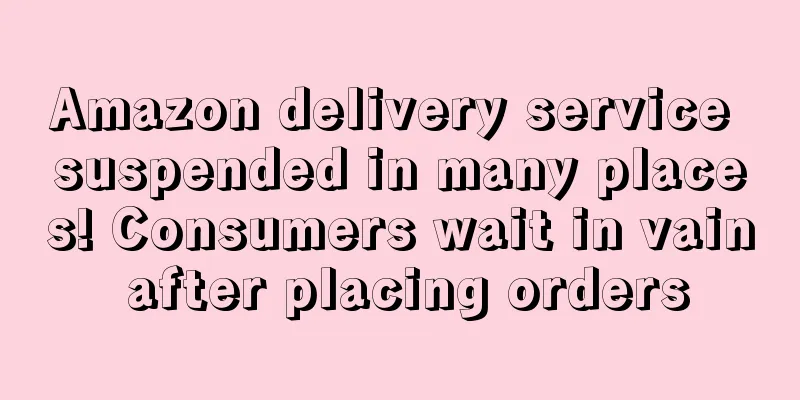Amazon has added a new fee!

|
Recently, Amazon has been updating its policies intensively, including changes in promotional reporting activities, warehouse configuration fees, FBA delivery, lost item claim process, logistics punctuality requirements, etc., which are dazzling. This article comprehensively sorts out the latest information to help sellers respond.
Three fee changes will increase sellers' expenses
Changes in Amazon's operating expenses are of most concern to sellers. Recent changes include three items: fees will be charged for Black Friday and Cyber Monday Prime exclusive discounts, warehousing configuration fees at some warehouses in the western United States have quietly increased by 50%, and the European site has urged sellers who have not configured insurance to purchase insurance.
1. Prime exclusive discounts will be charged
According to Amazon's internal information, the platform will extend the Black Friday /Cyber 1 promotion this year. It is reported that the 2024 Black Friday/Cyber 1 promotion will be extended to 12 days, from November 21 to December 2.
Flash sales, coupons, and top promotions are all common promotional methods used in big sales. Among them, Prime exclusive discounts are expected to be available for submission in mid-October, but unlike previous years, there is a fee for submitting this promotion. The platform will charge a fee of US$50 for each Prime exclusive discount. This is a one-time fixed fee, and a separate invoice will be issued after the event ends.
Several investment managers have confirmed that Prime exclusive discounts will soon be charged. This is not good news for many sellers who are used to participating in big promotions at a low cost, because some sellers may only participate in free promotions, and the first choice is Prime exclusive discounts. The industry speculates that perhaps Amazon has found that sellers are keen on free promotions and the results are good, so it has also included them in the charging items.
As expected, this caused dissatisfaction among sellers: "Amazon is trying to squeeze sellers dry. First, there are the warehouse configuration fees, low inventory fees, and return processing fees. These three items have squeezed a lot of profits. Membership exclusives are also charged. Will A+ and linking fees also be charged in the future? It's getting harder and harder."
Sellers are worried that this will incur a considerable fee. If the fee is charged by SKU, then shoes and clothing and other multi-variant products will be forced to do flash sales. However, it is understood that Amazon charges $50 based on a promotion, not an ASIN. For example, if a member-only promotion is created, it can include up to 500 ASINs.
In addition, with the start of the autumn promotion and Black Friday activities, only the member-exclusive discounts during the promotion will be charged, and there is no such expense on weekdays. Even so, it is an additional cost for sellers.
This year's autumn promotion will still last for 2 days, and the promotion will be reported soon. It is currently open to some sellers. Sellers can refresh the advertising path in the seller backend, search for the ASIN that can be reported for any flash sale, and submit the report.
2. Some warehousing configuration fees have increased, about 50% more per item
In March, Amazon began charging a warehouse configuration fee. In order to minimize the delivery cost, sellers had to think hard and make multiple delivery plans at once, and then calculate the most reasonable route. But after Member Day, without Amazon's clear notice, many sellers found that this fee had quietly increased. "Before Member Day, about one kilogram of products were shipped to three warehouses in the western United States. The warehouse configuration fee was about 1.76 yuan per unit, but now it is 2.46 yuan."
One seller pointed out that his products were shipped from three warehouses in the US West Coast. Previously, the cost per piece was about $0.2, but now the cost is $0.28. Another seller said that under the same warehouse division, his cost per piece increased from $0.16 to $0.24, a 50% increase.
After the price increase, the total shipping cost of sellers has also risen. Some sellers plan to change their strategies: "After the price increase, the total cost of shipping my products from 3 warehouses to the West Coast of the United States is almost the same as the total cost of shipping from 5 warehouses without configuration fees. The shipping cost has increased by several thousand this time. When the inventory is connected and the low inventory fee is no longer charged, I will also start to ship from 5 warehouses slowly."
In addition, it should be noted that if the seller chooses to ship to the West and East Coast of the United States at the same time in order to balance the shipping costs, it is necessary to avoid the time interval between the two entering the warehouse exceeding 30 days. In this case, the seller will not only have to pay a small warehousing defect fee, but will also be charged a higher configuration fee.
"If you send three shipments, and receive the last one 30 days after the first shipment, you will be charged an additional fee. Even an hour's difference will not work. I was charged an extra $500 for this reason," said a seller.
The configuration fee is charged separately 45 days after the shipment is received . The actual amount may be ignored. Sellers can view it by entering the shipment number in the backend transaction list.
The operations department is very distressed about this: "The warehousing configuration fees are too complicated now, and the company does not announce the unit price of freight, so I don't know how to ship the goods cost-effectively. Currently, shipments are made based on the boss's suggestions after several simple calculations, but the configuration fees are becoming more and more complicated, and I may have wasted money in many cases." One seller concluded that it is most cost-effective to divide light goods into five warehouses, while heavy goods have cheaper freight rates via the West Coast of the United States.
3. European station urges customers to purchase insurance again
Two months ago, Amazon notified sellers that they would also need to purchase insurance if they reached the sales threshold on the European and Canadian sites. With the experience of the US site, many sellers did not care about this and delayed it as much as possible. But in recent days, Amazon has once again sent mass emails urging sellers to equip sales on these sites with insurance.
According to Amazon's requirements, insurance is required if monthly sales reach a certain standard. The insurance is 4,000 pounds for the UK site, 5,000 euros for Germany, France, Italy, Spain, and the Netherlands, 50,000 Swedish kronor for Sweden, and 10,000 Canadian dollars for Canada.
For sellers who want to develop in the European site for a long time, this fee cannot be saved. If the seller has purchased liability insurance in the US site, he can confirm with the insurer whether the policy covers claims filed in the EU, UK and other sites. If not, he can ask them to add sites, and then upload the policy to the European site.
Amazon's logistics policy changes involve four items
In the first half of the year, Amazon increased its logistics costs significantly. Recently, the platform has begun to streamline its processes and raise requirements, sending out four notifications in just one week.
1. The lost item claim process has changed
Recently, some Amazon warehouses have been overwhelmed, and the listing of products has been very slow. At the same time, the probability of sellers losing goods has increased significantly compared to usual. Many sellers are facing the problem of claims after the loss of goods. A few days ago, Amazon US updated the claims process.
Starting November 1, 2024, Amazon will proactively compensate sellers for FBA items lost at distribution centers. Once the distribution center reports the item lost, the platform will immediately issue compensation, which sellers can track in the backend compensation report .
This seamless experience can minimize manual research and submission of lost goods claims, saving sellers time and money. However, how to enable the distribution center to smoothly and accurately confirm the lost items and quantity will still be a problem. For example, although Amazon said that almost all claims related to warehouse loss, damage, and returns will be actively compensated, there are still many sellers who are arguing with Amazon over the issue of who is responsible for the lost items.
For lost or damaged inventory, if the seller does not receive automatic compensation, they will need to submit a claim manually. Starting October 23, Amazon will update the eligibility window policy. All manual claims must be submitted within the following deadlines:
-For merchandise lost or damaged at a fulfillment center, fulfillment center claims must be submitted within 60 days of the item being reported lost or damaged. -FBA customer return claims may be submitted 60-120 days after the customer refund or exchange date. Claims may not be submitted earlier than 60 days to ensure that the customer has time to return the item for processing. -You can submit a removal claim for items lost in transit between 15 and 75 days from the date of shipment. Claims must be made no earlier than 15 days to ensure the shipment can be returned to you. - All other removal claims must be made within 60 days of the goods being returned to you.
It is good that Amazon proactively compensates for lost items, but compared to the current 18-month claim period, the new claim policy greatly shortens the period for proactive claims. If sellers fail to submit claims within the specified time, they will not be able to get compensation from Amazon, and the whereabouts of many lost goods may take several months to be determined.
2. The European site must provide the product's origin, otherwise it will be prohibited from selling
In recent days, sellers on the European site have received notifications that their products are missing origin information. According to EU and UK customs legislation, Amazon is required to collect the origin information of goods shipped from other countries to the UK or EU through the Amazon Logistics Export Program, as well as between the UK and the EU.
In the coming months, cross-border sales of products that lack origin information will be restricted. For existing products, if sellers do not provide country of origin/origin information for all existing products within the applicable scope before December 31, 2024, their products will be considered non-compliant and will be prohibited from cross-border sales; for new products, if the origin information of the products cannot be provided, new products will not be successfully created.
To lift the restrictions, sellers need to confirm that they will provide origin information before December 31, 2024. Sellers can upload origin information by product in "Inventory-Manage All Inventory" or in "Catalog-Bulk Upload Products" to upload in bulk.
It is important to note that if the product is entirely produced or manufactured in one country, then that country is usually the country of origin of the product. If the production or manufacturing of the product involves multiple countries, then the country of origin is usually the place where the product was last "substantially transformed".
3. The Pan-European Inventory Accelerator Program will be terminated tomorrow
The European market involves sales in multiple countries, and inventory allocation and taxation are a major challenge. Amazon's Pan-European Inventory Accelerator Program ( "COS") simplifies this process. Through this program, sellers only need to have a VAT registration number in Germany, France, Italy or Spain to enable local warehousing in any of these countries, and Amazon will also allocate inventory within several countries as appropriate.
However , Amazon announced that the Pan-European Inventory Accelerator program will end on August 1, 2024. Before then, sellers can continue to sell existing COS inventory and pay local FBA fees, but will no longer be able to enable the Pan-European Inventory Accelerator in other countries. After August 1, sellers will no longer pay local FBA fees in countries where they previously enabled COS, but will instead pay European Fulfillment Network (EFN) fees.
As a response, if sellers want to continue to store inventory in countries that used to use COS and pay local FBA fees, they can enable Amazon Logistics Europe Pan-European service through a VAT registration number (VRN).
If sellers do not enable Pan-European FBA with a VAT registration number by August 1, Amazon will automatically return Pan-European Inventory Accelerator inventory to an Amazon fulfillment center in the country where the inventory was originally shipped, free of charge, by August 31, 2024. If for some reason the inventory cannot be automatically returned, the platform will use an alternative solution.
After the accelerator program is terminated, sellers will have to pay the European delivery network fee, which will result in higher logistics costs. In addition, they will need to register for a VAT number to maintain normal sales. Considering that it takes some time to obtain a VAT registration number, Amazon has provided a corresponding solution for sellers who wish to use the Amazon Logistics Europe integration service through the tax number:
First, if sellers enable Amazon Logistics Pan-European Services through VRN between now and November 1, the platform will compensate €540 per country for registering for a VAT registration number in a COS-enabled country (Germany, France, Italy or Spain), as well as 12 months of tax declarations.
Secondly, if sellers enable Amazon Logistics Europe Integration through VRN between August 1 and November 1, the cost difference between the European distribution network fees and local FBA fees will be compensated for products previously registered for COS.
Although Amazon has provided a compensation plan, for sellers participating in the accelerator program, registering tax numbers and managing inventory is a rather tedious and costly task, which is bound to be a headache.
4. Update of self-delivery performance indicators has caused a stir among overseas sellers
In order to ensure the timeliness of delivery and to be allocated more traffic by the system, most Amazon sellers will use FBA for delivery. The proportion of domestic sellers using FBA is even higher, about 80%. However, compared with FBA, it is easier for self-delivery sellers to prepare goods, with less inventory pressure, and more room for product selection. Therefore, self-delivery also has a considerable market share. Some sellers insist on using self-delivery because of its low risk.
However, self-delivery is not enough to ensure timeliness, especially in the context of Temu, SHEIN and other platforms starting to focus on overseas local delivery products, which may affect the consumer experience. In order to reduce delayed delivery and increase delivery speed, Amazon has started to change its on-time delivery rate (OTDR) policy.
Starting September 25, 2024, self-delivery sellers will need to maintain at least a 90% on-time delivery rate (OTDR) without extending their commitments to protect their Amazon account performance. Amazon explained that the new requirements for self-delivery performance indicators are intended to help sellers improve their sales and operational capabilities and provide buyers with a better shopping experience. In addition, for a better buyer experience, Amazon recommends that sellers maintain an on-time delivery rate of 95% or higher.
Amazon has made several changes to shipping settings to help sellers on the Professional selling plan set accurate delivery dates:
Regarding delivery time settings, Amazon's delivery time requirements will be updated on August 25, 2024. If the seller ships within the continental United States (excluding Hawaii, Alaska, and U.S. territories), the maximum delivery time for standard delivery can be set to 5 days (applicable to all SKUs, except for media such as books, magazines, and DVDs), and the maximum delivery time for free economy delivery can be set to 8 days.
In terms of processing time settings, to help improve the accuracy of processing time, Amazon will enable automatic processing time (also known as processing time gap) for sellers whose manually configured processing time is two or more days slower than the actual processing time starting September 25, 2024. Sellers can view their time gaps in the Fulfillment Insight information center.
Overseas sellers in the United States and other countries are furious about this change. "Most of my orders are delivered on or before the promised delivery date. What's the point of using Amazon to buy shipping when you are going to make us responsible for delays with USPS carriers? This is ridiculous. I have done my part, and now Amazon needs to do its part and stop harassing FBM sellers."
The biggest complaint of sellers is that they are now responsible for the carrier's delays. In response, Amazon said that if a major disruption occurs that affects all sellers shipping to a specific area, the platform will not count the delayed shipments towards the seller's on-time delivery rate. However, whether a disruption is considered a major disruption is determined by Amazon at its discretion.
The platform also recommends that sellers choose highly reliable shipping methods to deliver orders on time, such as using Amazon Buy Shipping to purchase shipping labels. These shipping methods have a shield icon next to them and are marked as "OTDR protected."
These are some of the tools Amazon has designed to help you set accurate delivery dates, reduce late deliveries, and meet or exceed minimum OTDR requirements. If you use these, you can get OTDR protection for late deliveries on items shipped via standard shipping methods.
The first is Shipping Setup Automation (SSA) , which is available for the Professional Selling Plan and sets accurate delivery dates by automatically calculating the shipping time for the seller’s preferred shipping service. Sellers must select a preferred shipping method in the SSA template, which will mark the shipping time on the shipping template as “managed by Amazon.”
For Professional selling plans, Automatic Handling Time sets the exact handling time for each SKU based on how long it typically takes you to transfer each SKU to a carrier. You must ensure that Automatic Handling Time is enabled in your Shipping Settings.
Next is Amazon Buy Shipping , which is available for Professional and Individual selling plans and sells shipping labels that use highly reliable shipping methods. Sellers can use Amazon Buy Shipping through Manage Orders , the Shipping API , Veeqo , or choose a multi-channel integrator with access to Amazon Buy Shipping . Note that when using Amazon Buy Shipping or Veeqo, sellers must select shipping labels marked as "OTDR protected."
Amazon has raised the on-time delivery rate requirements, which has brought considerable operational challenges to self-delivery sellers. If their delivery rate does not meet the minimum requirements, Amazon will send an email to remind you of the current delivery rate and give you suggestions for improvement. |
>>: New warehouse opened! Cainiao International Express Weihai Preferred Warehouse Phase II opened
Recommend
Amazon leads in Portugal, Decathlon in the spotlight
According to a survey conducted by research insti...
Shenzhen police reported that four people were detained for charging for appointments and disrupting the order of Yantian Port
Yantian Port has been attracting much attention r...
Clubhouse welcomes another competitor! LinkedIn enters the audio market
Application researcher Alessandro Paluzzi shared ...
Good news! eBay UK fixed-value fees are reduced by two-thirds
Recently, eBay issued an announcement stating tha...
Columbia flip-flop sales grew against the trend, with comfortable footwear accounting for 75% of sales!
According to the eltiempo website, due to the red...
A large number of Chinese sellers have been maliciously sued for infringement, and some have won the case!
According to foreign media reports, since last ye...
Amazon launches full hosting! A large number of sellers are seeking to join
Yesterday, Amazon announced a new low-price store...
Cainiao International: The epidemic has catalyzed the development of cross-border logistics. Cross-border direct delivery and overseas warehouses meet the differentiated needs of merchants
On December 28, at the "Second Annual Confer...
What is Xigua Chuhai? Xigua Chuhai Review, Features
Xiguachuhai is a website focusing on cross-border ...
What is Straand? Straand Review, Features
Straand is a scalp care product provider that is ...
What is Primaseller? Primaseller Review, Features
<span data-docs-delta="[[20,{"gallery"...
Surcharges at West Coast ports skyrocketed, with a fine of $410,000 for a 90-day overdue payment!
In order to ease shipping congestion and containe...
What is Warren? Warren Review, Features
Warren is a Brazilian online investment platform ...
New Zealand's retail sales rise in first quarter
New Zealand's total retail sales rose a seaso...
Sellers choose to commit suicide? Amazon "falls from the altar"
Recently, the news that the boss of a cross-borde...









